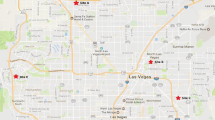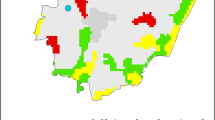Abstract
This study presents the results of a Europe-wide training and Quality Control (QC) exercise carried out within the framework of the European Aerobiology Society’s QC Working Group. The main aim of this exercise was to examine the feasibility of carrying out a QC exercise for fungal spore monitoring in Europe, using a similar methodology to the one previously used for pollen. The QC survey was conducted in two parts: (1) Coordinators of national and regional aerobiological networks in Europe involved in the monitoring of atmospheric fungal spores were invited to complete a questionnaire survey related to their network and asked whether they were interested in taking part in an external inter-laboratory QC exercise; (2) Participating networks performed an inter-laboratory ring test with the same sample slide in order to determine the reproducibility of identifying and counting two fungal spore taxa (Alternaria and Epicoccum) in air samples collected by a Hirst-type volumetric spore trap. Participants were instructed to read five separate longitudinal transects in the “effective collecting area” of the slide. Reproducibility of analysis was determined following the method previously used in the European Aerobiology Society’s QC exercises for pollen. Thirty-two counters from 16 national or regional networks in Europe participated in the QC exercise. Coefficients of Variation (CV%) ranged from 23.0 to 22.5 when reading one transect and from 14.0 to 16.0 when reading five transects for Alternaria and Epicoccum, respectively. Considering a CV% of 30 as the limit for fungal spores, no significant differences were observed between the absolute errors from two, three, four and five transects. The only significant difference was between one and five transects. We recommend that fungal spore analysis should be carried out on about 5% of the slide (two transects in this study) because results were not significantly different to five transects.



Similar content being viewed by others
References
Abraira, V. (2002a). Estimación: Intervalos de confianza. SEMERGEN-Medicina de Familia, 28(2), 84–85.
Abraira, V. (2002b). Desviación estándar y error estándar. SEMERGEN-Medicina de Familia, 28(11), 621–623.
Agarwal, M. K., Jones, R. T., & Yunginger, J. W. (1982). Shared allergenic and antigenic determinants in Alternaria and Stemphylium extracts. Journal of Allergy and Clinincal Immunology, 70, 437–444.
Buters, J. T., Antunes, C., Galveias, A., Bergmann, K. C., Thibaudon, M., Galán, C., Schmidt-Weber, C., & Oteros, J. (2018). Pollen and spore monitoring in the world. Clinical and translational allergy, 8(1), 9.
CEN. (2019). EN 16868:2019 Ambient air—Sampling and analysis of airborne pollen grains and fungal spores for allergy networks - Volumetric Hirst method. CEN-CENELEC Management Centre: Rue de la Science 23, B-1040 Brussels, European Committee For Standardization
Cole, G. T., & Samson, R. A. (1979). Patterns of development in conidial fungi. Pitman Publishing.
Galán, C., Smith, M., Thibaudon, M., Frenguelli, G., Oteros, J., Gehrig, R., Berger, U., Clot, B., & Brandao, R. (2014). Pollen monitoring: Minimum requirements and reproducibility of analysis. Aerobiologia, 30(4), 385–395.
Green, B. J., Schmechel, D., & Tovey, E. R. (2005a). Detection of aerosolized Alternaria alternata conidia, hyphae, and fragments by using a novel double-immunostaining technique. Clinical and Diagnostic Laboratory Immunology, 12(9), 1114–1116.
Green, B. J., Sercombe, J. K., & Tovey, E. R. (2005b). Fungal fragments and undocumented conidia function as new aeroallergen sources. Journal of Allergy and Clinincal Immunology, 115(5), 1043–1048.
Grewling, Ł, Bogawski, P., Szymańska, A., Nowak, M., Kostecki, Ł, & Smith, M. (2020). Particle size distribution of the major Alternaria alternata allergen, Alt a 1, derived from airborne spores and subspore fragments. Fungal Biology, 124, 219–227.
Gutiérrez-Rodríguez, A., Postigo, I., Guisantes, J. A., Suñén, E., & Martínez, J. (2011). Identification of allergens homologous to Alt a 1 from Stemphylium botryosum and Ulocladium botrytis. Medical mycology, 49(8), 892–896.
Hirst, J. M. (1952). An automatic volumetric spore trap. The Annals of Applied Biology, 39(2), 257–265.
ISO 5725-1:1994. Accuracy (trueness and precision) of measurement methods and results—Part 1: General principles and definitions. Comitte: ISO/TC 69/SC 6—Measurement methods and results.
Magyar, D. (2007). Aeromycological aspects of mycotechnology. In M. K. Rai (Ed.), Mycotechnology: Current trends and future prospects (pp. 226–263). I.K. International Publishing House.
Magyar, D., Frenguelli, G., Bricchi, E., Tedeschini, E., Csontos, P., Li, D. W., & Bobvos, J. (2009). The biodiversity of air spora in an Italian vineyard. Aerobiologia, 25(2), 99–109.
Milic, A., Addison-Smith, B., Jones, P. J., Beggs, P. J., Erbas, B., & Davies, J. M. (2020). Quality control of pollen identification and quantification exercise for the AusPollen Aerobiology Collaboration Network: A pilot study. Aerobiologia, 36, 83–87.
Mueller, G. M., & Schmit, J. P. (2007). Fungal biodiversity: What do we know? What can we predict? Biodiversity and Conservation, 16, 1–5.
Oteros, J., Galán, C., Alcázar, P., & Domínguez-Vilches, E. (2013). Quality control in bio-monitoring networks, Spanish Aerobiology Network. Science of the Total Environment, 443, 559–565.
Pady, S. M., & Kramer, C. L. (1960). Kansas Aeromycology. VI. Hyphal fragments. Mycologia, 52, 681–687.
Rotem, J. (1994). The genus Alternaria. APS Press.
Sáenz-de-Santamaría, M., Postigo, I., Gutierrez-Rodríguez, A., Cardona, G., Guisantes, J. A., Asturias, J., & Martinez, J. (2006). The major allergen of Alternaria alternata (Alt a 1) is expressed in other members of the Pleosporaceae family. Mycoses, 49(2), 91–95.
Smith, M., Oteros, J., Schmidt-Weber, C., & Buters, J. T. (2019). An abbreviated method for the quality control of pollen counters. Grana, 58(3), 185–190.
Smith, M. & Sikoparija, B. (2020). Interlaboratory proficiency test in aerobiology using virtual slides—Feasibility study. Grana (in press).
Sikoparija, B., Galán, C., & Smith, M. (2017). Pollen-monitoring: between analyst proficiency testing. Aerobiologia, 33, 191–199.
Starink, R. J., & Visser, R. G. (2010). Interlaboratory studies: Protocol for the organisation, statistics and evaluation. Institute for Interlaboratory Studies I.I.S.
Woudenberg, J. H. C., Groenewald, J. Z., Binder, M., & Crous, P. W. (2013). Alternaria redefined. Studies in Mycology, 75, 171–212.
Woudenberg, J. H. C., Hanse, B., Van Leeuwen, G. C. M., Groenewald, J. Z., & Crous, P. W. (2017). Stemphylium revisited. Studies in Mycology, 87, 77–103.
Acknowledgments
The authors would like to thank the EAS QC Working Group, for their important contribution on this topic in the frame of the European Aerobiology Society (EAS).
Author information
Authors and Affiliations
Consortia
Corresponding author
Rights and permissions
About this article
Cite this article
Galán, C., Smith, M., Damialis, A. et al. Airborne fungal spore monitoring: between analyst proficiency testing. Aerobiologia 37, 351–361 (2021). https://doi.org/10.1007/s10453-021-09698-4
Received:
Accepted:
Published:
Issue Date:
DOI: https://doi.org/10.1007/s10453-021-09698-4




